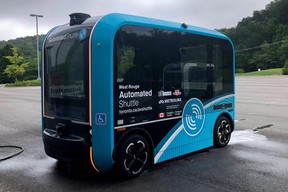City of Toronto to pilot autonomous shuttle project
It'll ply the West Rouge area this fall and winter

Article content
If you’ve always wanted to commute to work in a machine that looks like Captain Picard’s toaster, the West Rouge Automated Shuttle Trial may be for you.
Advertisement
Article content
Part of a project launched in partnership between the City of Toronto, Metrolinx, and the Toronto Transit Commission (TTC), this temporary trial uses a low-speed automated vehicle based out of the Rouge Hill GO station. Fixed-location stops will provide access to the West Rouge neighbourhood, plus its community centre and national urban park. Its autonomous driving system means the machine will halt at every designated shuttle stop so passengers do not have to inform the attendant in advance that they wish to disembark.
And, yes, there will be a human attendant on board to take over driving duties if required. Service will align with GO schedules, though its route and times of operation are different on weekdays versus the weekend. Bank on seeing this thing during peak times, such as between 6:00 am and 9:00 am during the week. Detailed schedule information will be finalized next month.
Advertisement
Article content
Speaking of, this temporary service will be free to use but people who want to ride the shuttle will need to book a trip, limiting passengers on a single ride to people within one household. This is both a function of the shuttle’s small size (up to 8 passengers) and existing COVID restrictions. While the automated shuttle trial won’t begin until October, residents will see the vehicle in their neighbourhood mid-September as the planning committee carries out testing.
Why this time of year? Those behind the program want to give the shuttle a good shakedown in the midst of a typical Canadian winter. Weather will be monitored and the shuttle may be taken out of service if conditions are poor. The shuttle is powered by an electric motor, so the team wants to see what effect our climate has on the unit’s battery life. If you’re wondering, the vehicle can travel up to 20 km/h in autonomous mode or double that speed when the human attendant has taken its controls.
The shuttle, which is called the Olli 2.0 and produced by a company named Local Motors, is planned to be in service until February 2022. Right now, there is no intention to make it a permanent project, or to scale up the use of automated shuttles.


